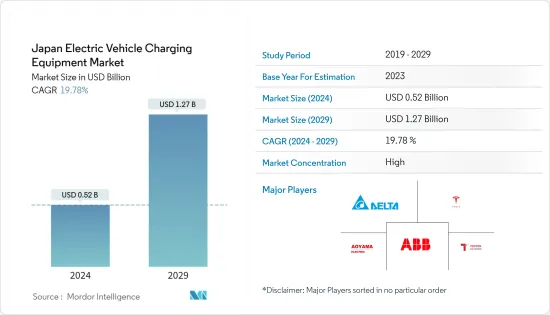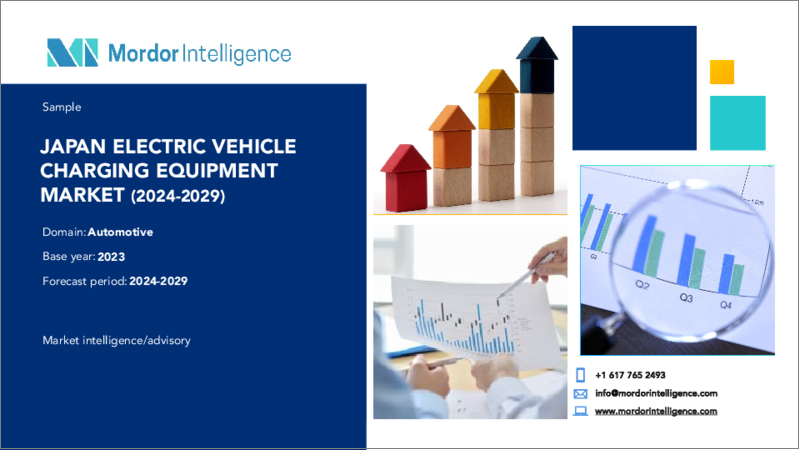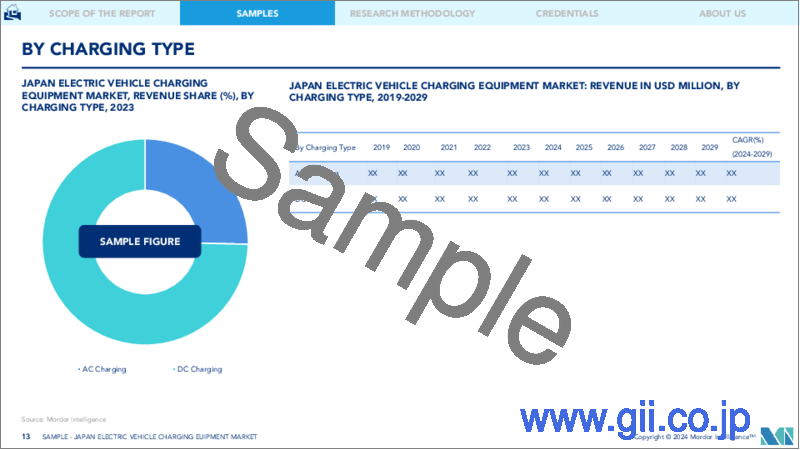|
|
市場調査レポート
商品コード
1432977
日本の電気自動車充電設備:市場シェア分析、産業動向・統計、成長予測(2024年~2029年)Japan Electric Vehicle Charging Equipment - Market Share Analysis, Industry Trends & Statistics, Growth Forecasts (2024 - 2029) |
||||||
カスタマイズ可能
適宜更新あり
|
|||||||
| 日本の電気自動車充電設備:市場シェア分析、産業動向・統計、成長予測(2024年~2029年) |
|
出版日: 2024年02月15日
発行: Mordor Intelligence
ページ情報: 英文 70 Pages
納期: 2~3営業日
|
全表示
- 概要
- 目次
日本の電気自動車充電設備市場規模は2024年に5億2,000万米ドルと推定され、2029年には12億7,000万米ドルに達すると予測され、予測期間中(2024-2029年)のCAGRは19.78%で成長すると予測されます。

COVID-19の発生が市場に悪影響を与えています。同国における電気自動車の販売は妨げられ、電気自動車の市場シェアは非常に低いです。この年の販売低迷の主な原因は、経済活動が長期にわたって停止したため、厳しい封鎖措置がとられたことです。2020年3月には、国内の充電ステーション数が約1,087カ所減少し、29,233カ所となったことが記録されています。充電スタンドが減少した理由は、日本で販売される新車に占める電気自動車の割合がわずか1%であるため、充電スタンドがあまり利用されていないためです。古くなったスタンドもあれば、撤去されたスタンドもあります。
日本では、プラグイン・ハイブリッド車の数が多く、バッテリー電気自動車とその使用に対する需要が高まっているため、電気自動車用充電ステーションの需要が大幅に増加し、業界の市場機会が拡大しています。さらに、日本では2010年度以降、ステーション数が着実に増加しています。2010年の充電ステーション数は約310ヵ所であったが、2021年には30,000ヵ所以上に増加します。
2050年までにカーボン・ニュートラルを目指す日本政府は、電気自動車の普及を促進するため、充電ステーションに補助金を支給しています。日本政府はグリーン燃料車の販売を後押ししており、2035年までに販売される新車はすべて電気自動車とハイブリッド電気自動車の両方で電気を動力源とするという野心的な計画を持っています。これは、予測期間中の電気自動車充電設備需要を高めると思われます。
日本のEV充電ステーション市場動向
電気自動車販売を促進する政府の取り組みが市場に好影響を与える
日本政府は、電気自動車(HEV、PHEV、BEV)の普及を奨励することで、環境問題への関心を高めています。これに伴い、道路を走る電気自動車の数は絶えず増加しており、関連する充電インフラの需要を促進する可能性が高いです。
5大乗用車市場には、中国、米国、ドイツ、インド、日本が含まれます。2020年12月、日本政府は、電気自動車、燃料電池電気自動車、プラグインハイブリッド自動車、ハイブリッド自動車を推進することで、2050年までに日本をカーボン・ニュートラルにするグリーン成長戦略を導入しました。
これらの実施により、日本は、パリ協定の下でのGHG(温室効果ガス)削減目標を達成するため、運輸部門からの排出影響を削減しようとしています。日本における充電ステーションの集中度は、他の先進諸国に比べかなり低く、今後数年間での大きな成長の可能性を示しています。例えば、2021年には、日本は道路100kmあたりわずか1.7カ所の充電ステーションしかなかったのに対し、韓国は約75.2カ所だった。2020年には、日本には合計29,855基の充電ステーション(21,916基の普通充電器と7,939基の急速充電器)があります。しかし、充電技術に関する特許出願件数は1,310件を超え、日本は世界第2位です。
日本は、気候変動に打ち勝ち、炭素排出を最小限に抑えるための自動車産業の長期目標と戦略を持っています。今後半世紀にわたり、政府は電気自動車を推進するため、イノベーション、政策、インフラ投資を含む3つの主な行動を設定しています。イノベーションの推進、リチウムイオン電池の開発、経済的調達ルートの構築、次世代技術の開発。
政策では、世界・サプライチェーンの強化、国際的な電動化政策の取り込み、燃料基準の最大化に注力しています。インフラ整備では、電池部品調達の安定化による電池ネットワークの構築、使用済み電池のリユース・リサイクル指針の確立、ワイヤレス充電インフラの研究開発への投資が1次調査となります。2021年11月、日本政府は電気自動車に対する優遇措置を1台当たり80万円に倍増すると発表し、北米や欧州などの成熟した経済圏に追いつくために充電インフラへの補助金を支給します。
高い設置費用とメンテナンス費用が市場成長の妨げになる見通し
EV充電ステーションの設置コストはかなり高く、設置する充電器のタイプによって異なります。EV充電インフラを設置するためには、最低限のインフラ要件を満たす必要があり、適切なベンダーと場所を見つけることが重要です。充電インフラのコストには、固定費(設置、ユーティリティサービス、変圧器、設備)と変動費(電気料金)が含まれます。
商用電力料金の充電器の場合、需要料金が運転コストの大半を占めることがあります。その結果、急速充電ステーションの総電力コストは、前者が十分に高い稼働率を達成しない限り、低速の住宅用充電器よりも高くなります。
現在の利用率レベルでは、商用充電器は経済的に採算が合わないことがほとんどです。商業用充電インフラが経済的利益を上げ、ICエンジンと競争するには、大幅かつ持続的な需要の増加が必要です。
ピーク時にEVの家庭充電が集中すると、地域の変圧器に過負荷がかかる可能性があります。電力会社は、需要をオフピーク時間帯にシフトさせることができない限り、ピーク時の容量を追加調達しなければならない可能性があります。
EV用の充電器には3つのタイプがあります。家庭用電化製品によく使われる標準的な120Vプラグは充電速度が遅いが、約8~12時間でバッテリーを満タン近くまで充電できます。240Vのレベル2充電器は、一般的に1時間で20~25マイルの充電が可能で、充電時間は8時間以内に短縮されます。一般家庭では、レベル2充電器は衣類乾燥機や電気オーブンに必要なものと同じタイプのコンセントを使用することができます。レベル3の直流(DC)急速充電器は、30分でバッテリーを80%まで充電できます。
自動車メーカーによって、3種類のDC急速充電器が使用されています。ほとんどのメーカーはSAEコンバインド・チャージング・システム(CCS)を使用し、CHAdeMOは日産と三菱が使用し、テスラ・スーパーチャージャーはテスラ車のみが使用しています。このような車両の互換性の欠如は、充電ステーションへの普遍的な車両のアクセスを制限し、市場の成長を妨げる可能性があります。
高出力エネルギー充電器の配備は、ステーションの利用率が高くなるよう慎重に行わなければならないです。現在のシナリオでは、充電ステーションの収益性はかなり低いです。収益性が高まるのは、電気自動車が十分に普及し、インフラが高稼働率を維持できるようになってからかもしれないです。例えば、2020年のBEVの販売台数は1万4,604台であるのに対し、ハイブリッド車は同期間に132万4,800台の販売台数を超えています。
日本のEV充電ステーション産業の概要
電気自動車充電ステーション市場は比較的統合されており、主要な市場シェアは数社によってカバーされています。主な参入企業は、ABB、デルタ電子、トヨタなどです。国内の主要企業は、最新技術を開発するために他のプレーヤーとジョイント・ベンチャーを結んでいます。また、さまざまな自動車メーカーが、電気自動車とともに家庭用充電ソリューションを顧客に提供しています。例えば、
- 2021年11月、SUBARU社は初の電気自動車(EV)であるSolterraを発表しました。Solterraは、住宅用充電器でゼロから100%までフル充電するのに13時間近くかかります。しかし、ソルテラはレベル3の直流急速充電器で1時間以内に80%の充電が可能で、航続距離は320km以上と見積もられています。
- 2021年10月、トヨタ自動車は新型BEV(バッテリー電気自動車)「bZ4X」の詳細を発表しました。bZ4Xは、ミディアムセグメントSUVタイプのBEVで、トヨタbZシリーズの第1弾モデルです。スバル株式会社と共同開発したBEV専用プラットフォームを採用。付属の家庭用壁掛け充電器により、10時間でフル充電が可能。
その他の特典:
- エクセル形式の市場予測(ME)シート
- 3ヶ月間のアナリストサポート
目次
第1章 イントロダクション
- 調査の前提条件
- 調査範囲
第2章 調査手法
第3章 エグゼクティブサマリー
第4章 市場力学
- 市場促進要因
- 市場抑制要因
- ポーターのファイブフォース分析
- 新規参入業者の脅威
- 買い手・消費者の交渉力
- 供給企業の交渉力
- 代替品の脅威
- 競争企業間の敵対関係の強さ
第5章 市場セグメンテーション
- 最終用途
- 家庭用充電
- 公共充電
- 充電ステーション
- AC充電ステーション
- DC充電ステーション
第6章 競合情勢
- ベンダー市場シェア
- 企業プロファイル
- ABB Ltd
- Delta Electronics Inc.
- e-Mobility Power Inc.
- Toyota Connected Corporation
- Tesla Inc.
- Aoyama Elevator Global Ltd
- Tritium Charging
- NEC Telecommunication and Information Technology Ltd
第7章 市場機会と今後の動向
The Japan Electric Vehicle Charging Equipment Market size is estimated at USD 0.52 billion in 2024, and is expected to reach USD 1.27 billion by 2029, growing at a CAGR of 19.78% during the forecast period (2024-2029).

The outbreak of COVID-19 has negatively impacted the market. The sales of electric vehicles in the country were hampered, and the market share of electric vehicles is very low. The major reason for the low sales during the year was the strict lockdown measures as economic activities were stopped for a long time. In March 2020, it was recorded that the number of charging stations in the country reduced by around 1,087 to 29,233 charging stations. The reason for the reduction in charging stations is that electric vehicles account for only one percent of the new cars sold in Japan because the charging stands are not being used very much. Some of them are outdated, and others have been removed.
The high number of plug-in hybrids and the growing demand for battery electric vehicles and their usage in the country significantly boosted the demand for electric vehicle charging stations and increased market opportunities for the industry. Further, number of stations has been growing steadily in Japan since fiscal 2010. In 2010, there were around 310 charging stations in the country, which increased to more than 30,000 stations in 2021.
Major subsidies offered by the country's government to promote the use of electric vehicles, as an effort to become carbon neutral by 2050, led to subsidizing the charging stations in the country. This is likely to drive the market's growth during the forecast period.The Japanese government is boosting the sales of green fuel vehicles and has an ambitious plan that all the new vehicles sold by 2035 will be powered by electricity, both electric and hybrid electric vehicles. This will enhance electric vehicle charging equipment demand during the forecast period.
Japan EV Charging Stations Market Trends
Government Initiatives to Boost Electric Vehicle Sales to Have Positive Impact on the Market
Surging carbon emission by the transportation sector has propelled the environmental concern across Japan, which is scrutinized by Japan government by encouraging the adoption of electric vehicles, i.e., HEVs, PHEVs, and BEVs. With this, the number of electric vehicles on the road is constantly increasing, which is likely to drive the demand for associated charging infrastructure.
The five largest passenger car market includes China, the United States, Germany, India, and Japan. Along with several other countries across the world, Japan has committed to net zero-emission passenger car sales.In December 2020, Japan government introduced a green growth strategy to make Japan carbon neutral by 2050 by promoting electric vehicles, fuel cell electric vehicles, plug-in hybrid vehicles, and hybrid vehicles.
With these implementations, Japan seeks to reduce the emission impact from the transportation sector to achieve the GHG (Green House Gas) reduction goals under the Paris agreement.The concentration of charging stations in Japan is quite less compared to other developed countries, indicating massive growth potential in the coming years. For instance, in 2021, Japan had only 1.7 charging stations per 100 km of roadways, whereas South Korea had around 75.2. In 2020, Japan had a total of 29,855 charging stations (21,916 sallow chargers and 7,939 fast chargers). Although, Japan accounts for the second position in charging technology patents across the world, with more than 1,310 patent filings.
Japan has long-term goals and strategies for the automotive industry to beat climate change and minimize carbon emissions. For the next half-decade, the government has set three key actions to promote the electric vehicle, including innovations, Policies, and investment in infrastructure.Promotion for innovation, developing lithium-ion batteries, building economic procurement channels, and developing next-generation technologies.
Through policies, the country is focusing on robust the global supply chain, incorporating international electrification policies, and maximizing the fuel standards. In Infrastructural development, the primary focus would be building a battery network by stabilizing the battery components procurement, establishing a guideline for used batteries to reuse/recycle, and investing in research and development of wireless charging infrastructures. In November 2021, Japan government announced to double their incentives for electric vehicles to 800,000 Yen per vehicle and subsidizes charging infrastructure to catch up with matured economies, including North America and Europe.
High Cost of Installation and Maintenance Expected to Hinder Market growth
The cost of setting up an EV charging station is quite high and varies according to the type of chargers being installed. In order to set up the EV charging infrastructure, minimum infrastructure requirements need to be fulfilled, and finding the right vendor and location is important. The charging infrastructure costs include fixed (installation, utility service, transformers, and equipment) and variable (electricity charges) components.
For chargers on commercial electricity tariffs, demand charges can dominate operating costs. As a result, the total cost of power from fast-charging stations is higher than slower residential chargers unless the former can achieve sufficiently high utilization rates.
At current levels of utilization, commercial chargers are almost universally not economically profitable. A significant, sustained increase in demand will be needed for commercial charging infrastructure to deliver financial returns and compete with IC engines.
The high concentration of EV home charging during peak periods can overload local transformers. Utilities may have to procure additional peak capacities unless they are able to shift demand to off-peak periods.
There are three types of chargers available for EVs. The standard 120V plug, often used for home appliances, charges slowly but can fill a battery to near-full capacity in about 8 to 12 hours. The 240V level-2 chargers generally provide 20 to 25 miles of charge in an hour, which shortens charging time to eight hours or less. In homes, level-2 chargers can use the same outlet type required for clothes dryers or electric ovens. Level-3 direct current (DC) fast chargers can charge a battery up to 80% in 30 minutes.
Different auto manufacturers use three different varieties of DC fast chargers. Most manufacturers use the SAE Combined Charging System (CCS), the CHAdeMO variant is used by Nissan and Mitsubishi, and the Tesla Supercharger is used by only Tesla cars. This lack of vehicle compatibility restricts universal vehicle access to charging stations and could hinder market growth.
Deploying high-powered energy chargers must be done carefully to ensure stations have high utilization. The profit potential of charging stations is quite low in the current scenario. The profitability may only increase when there are enough electric cars on the road, so the infrastructure could have a high utilization rate. Consumer preference is more leaned toward hybrid vehicles, which significantly restraints the sales of BEVs; for instance, the sales of BEVs in 2020 was 14,604 units, whereas hybrid vehicles have surpassed the sales volume of 1,324,800 units during the same tenure.
Japan EV Charging Stations Industry Overview
The Electric vehicle charging station market is relatively consolidated, with a major market share being covered by a few companies. Some major players in the market are ABB, Delta Electronics Inc., Toyota, and others. The major players in the country are entering into joint ventures with other players to develop the latest technology. Various automakers are also providing home charging solutions to their customers along with electric vehicles. For instance,
- In November 2021, Subaru Corp unveiled its first all-electric vehicle (EV), the Solterra which takes almost 13 hours to fully charge from zero to 100 percent with the residential charger. However, Solterra also get an 80% charge in under an hour from a Level 3 DC fast charger giving out an estimated range to be greater than 320 km.
- In October 2021, Toyota Motor Corporation announced the details of bZ4X, its all-new model BEV (Battery Electric Vehicle). The bZ4X, a medium-segment SUV-type BEV, is the first model in the Toyota bZ series. The model adopts a BEV-dedicated platform jointly developed with Subaru Corporation. With provided home wall mount charger, car can reach full recharge in 10 hours.
Additional Benefits:
- The market estimate (ME) sheet in Excel format
- 3 months of analyst support
TABLE OF CONTENTS
1 INTRODUCTION
- 1.1 Study Assumptions
- 1.2 Scope of the Study
2 RESEARCH METHODOLOGY
3 EXECUTIVE SUMMARY
4 MARKET DYNAMICS
- 4.1 Market Drivers
- 4.2 Market Restraints
- 4.3 Porter's Five Forces Analysis
- 4.3.1 Threat of New Entrants
- 4.3.2 Bargaining Power of Buyers/Consumers
- 4.3.3 Bargaining Power of Suppliers
- 4.3.4 Threat of Substitute Products
- 4.3.5 Intensity of Competitive Rivalry
5 MARKET SEGMENTATION
- 5.1 End Use
- 5.1.1 Home Charging
- 5.1.2 Public Charging
- 5.2 Charging Station
- 5.2.1 AC Charging Station
- 5.2.2 DC Charging Station
6 COMPETITIVE LANDSCAPE
- 6.1 Vendor Market Share
- 6.2 Company Profiles*
- 6.2.1 ABB Ltd
- 6.2.2 Delta Electronics Inc.
- 6.2.3 e-Mobility Power Inc.
- 6.2.4 Toyota Connected Corporation
- 6.2.5 Tesla Inc.
- 6.2.6 Aoyama Elevator Global Ltd
- 6.2.7 Tritium Charging
- 6.2.8 NEC Telecommunication and Information Technology Ltd





